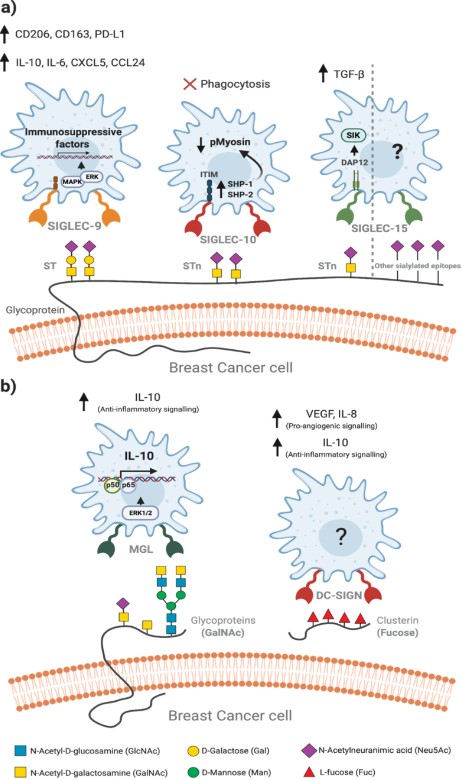Technologies for Glyco-code Based Diagnostics
A full understanding of how the cancer sugar code governs the immunosuppressive circuit in the tumor microenvironment is critical to the development of new diagnostic and therapeutic strategies. As an expert in this field, Creative Biolabs provides customers with a variety of advanced testing services.
Background of Glycan Code
The glycans on cell surface glycoproteins and glycolipids have undergone fundamental changes in tumor cells, and the result of this change is that tumor cells have a different glycan shell from healthy cells. More than half of the proteins in organisms have glycosylation modifications, including transcription factors, sugar metabolism-related enzymes. Glycosylation modifications affect protein spatial conformation, activity, transportation and positioning, and are widely involved in intercellular recognition, regulation, signal transduction, and physiological processes. Additionally, immune cells express numerous glycan-binding receptors called lectins. They can respond to changes in glycan characteristics, which often leads to immunosuppression and promotes immune escape. This process occurs by abnormally expressing self-glycan structures to limit the response of the immune system or by newly expressing glycan structures that can inhibit the function of effector T cells. Since one type of glyco-code can affect a variety of immune cells, glycans can greatly interfere with these immunosuppressive procedures. For this reason, deciphering the specific glycan characteristics of tumor cells, known as the glycan code, is very important for understanding the immunosuppression of the glycan-lectin circuit in the tumor microenvironment.
 Fig 1. Glycan-lectin interactions in the breast cancer microenvironment regulate the phenotype of tumor-associated cells.1, 2
Fig 1. Glycan-lectin interactions in the breast cancer microenvironment regulate the phenotype of tumor-associated cells.1, 2
The Glyco-Code in Cancer Diagnostics
Early stages of tumor development are usually accompanied by changes in glycosylation. Some tumor-associated glycans are expressed in different types of cancer, making them powerful early diagnostic markers. Therefore, a large number of technologies are used in this field. Liquid chromatography and mass spectrometry analysis are commonly used methods in cancer glycomics, which can perform a detailed analysis of all structural glycans of cancer cells. In addition, imaging mass spectrometry is a new detection method that is used to detect the distribution of N-linked glycan in various tumor tissues. A new high-throughput method has also attracted widespread attention. This method can characterize the structure of complex glycans in complex mixtures. However, the detection of single cells is limited to antibodies and lectins, which can be detected in single-cell suspensions with flow and mass cytometry. Moreover, lectins could also be used as a detection tool in cancer.
With the development of more and more technologies for determining gene expression, the expression status of glycosylation-related genes has become a new trend in diagnosis. Equipped with the well-constructed detection technology platform, Creative Biolabs is confident in proving a variety of detection methods for glyco-code based diagnostics services. Our services include but are not limited to the following:
Creative Biolabs is proficient in many new detection technologies, including but not limited to those mentioned above. If you have any questions about glyco-code detection, please contact us.
References
-
Lopes, Nuno, et al. "Cracking the breast cancer glyco-code through glycan-lectin interactions: targeting immunosuppressive macrophages." International Journal of Molecular Sciences 22.4 (2021): 1972.
-
Under Open Access license CC BY 4.0, without modification.
For Research Use Only.
Related Services

 Fig 1. Glycan-lectin interactions in the breast cancer microenvironment regulate the phenotype of tumor-associated cells.1, 2
Fig 1. Glycan-lectin interactions in the breast cancer microenvironment regulate the phenotype of tumor-associated cells.1, 2



